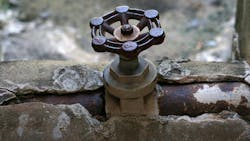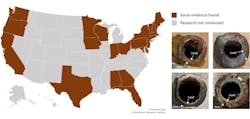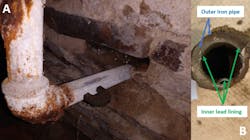Locating "lead-lined" iron pipes in drinking water distribution systems
As far back as the late 1800s, water service pipes that are lined with lead have been installed in drinking water systems throughout the U.S. The original manufacturer, Wakefield Galvanized of Wakefield, Massachusetts, touted lead-lined (LL) pipes as a low-cost corrosion-resistant alternative to other pipes, with easy installation and maintenance properties. Soon after, water departments across the United States, particularly in the Northeast and Midwest, began to incorporate LL pipes into their systems.
While the outer material of these pipes is steel or iron, the lining that contacts the drinking water is lead. For all intents and purposes, these are lead pipes (not galvanized pipes), despite appearances. There are records of lead-lined galvanized steel or galvanized iron in past or current use in several water systems in at least 23 states.
Detecting lead-lined galvanized steel
The presence of LL pipes further complicates the already difficult task of developing a lead service line inventory, in accordance with the EPA’s Lead and Copper Rule Revisions (LCRR) and Improvements (LCRI). Though some historical documentation of their use exists, there is often limited information at the level of individual services.
By their very nature, LL pipes obfuscate EPA’s standard identification methods for lead pipes. Basic examinations, like scratch and magnet tests, would have an observer believe the pipe is made of galvanized steel or iron, while in fact the pipe is lead-lined. Water analyses may not assist with identifying lead lining, since results can be inconclusive in systems with effective corrosion control or lead-containing plumbing and fixtures. Other methods for determining the presence of lead-lining have not been widely investigated, and just like for past lead use, no EPA-approved field detection method provides information about past use.
However, there are several options water agencies can employ to attempt to detect lead-lined galvanized steel. Here are seven ways to research LL pipe in a utility network:
1. Search for service line materials in historical records
Water systems may be able to use historical records, including city documents and/or national waterworks and insurance surveys, to preliminarily determine their historical use of LL pipes. There are many useful state or national resources available online or through state, university, or regional libraries.
2. Online public documents
Many early public documents can be found in online repositories like HathiTrust or Google Books. Some of these documents may include state-wide surveys or reports from municipalities about their water system that include service line material information. Documents may also be stored at state libraries or nearby university libraries; these can be identified by using the library catalogues WorldCat or HathiTrust, among others.
3. City boards of water commissioners
Internal city documents may also be available in online repositories, particularly reports that may have been made from a city’s water department, board of water commissioners, or public utilities division. These documents may have detailed service line material information, including kinds of pipe in use, amount installed per year, contracted manufacturers, and more.
4. National surveys
The Manual of American Water Works (MAWW) was a project undertaken by M.N. Baker of the Engineering News trade journal between 1888 and 1897. Individual water works were contacted and asked to submit information about their system, including the system’s history and its make-up.
5. Insurance year books
The Spectator Insurance Year Book: Fire and Marine Edition is another national resource that may help identify LL pipe usage in larger municipalities. The Year Book was compiled yearly and began including water system information around 1900.
6. Journals of the AWWA & AWWA state chapters
AWWA journals at both the national and state/regional chapter levels may also provide insight. Additionally, utilities may have published their findings from tests of different service line materials in these journals. These studies, depending on their level of detail, may indicate whether lead-lined iron was used and for how long.
7. Trade journals
Trade journals like the Municipal Journal and Public Works, The Engineering Record, Engineering News, American Contract Journals, and Fire and Water may also include relevant information, though much more sparingly. Contract journals may indicate when a municipality had announced it was taking bids for a project, which could narrow down the date range for searches in other documents. Even advertising can be used to help determine early materials in use.
Field detection methods
There may be ways to detect lead lining without cutting a pipe open, varying from direct visual inspection to remote sensing. The most direct way to detect lead-lining is to look inside a pipe with an exterior made of non-lead material. Other options are devices that use electrical resistance or conductance from a probe inserted inside the service line to determine the pipe material. However, not enough testing has been performed at this time to confirm the probes would accurately classify LL pipe and the level of disruption to the water quality, as well as the LCRR disturbance classification.
Various groups are piloting remote metal detectors which could not only detect the presence of metal, but the type of metal from the soil surface without digging. Additionally, attempts have been made to identify LL pipes using handheld x-ray fluorescence (XRF) devices, which emit a broad spectrum of x-rays to detect the presence and relative concentration of metals and other elements.
Summary
Lead-lined iron and steel pipes were widely used for drinking water in cities and utilities across the United States. While the knowledge and system records of their use is often unknown, they are still present in service line connections in many towns and cities. Standard visual inspection methods do not detect their presence and may give a false sense of security.
The historical sources presented in this article, as well as others, may assist with determining if a water system should conduct extra investigation methods with their service line inventory development. Utilities are encouraged to conduct a thorough search of the historical sources presented, as well as any additional records held by the utility, to determine whether LL pipe was ever permitted, purchased, or actively installed.
Additionally, it is recommended that utilities systematically investigate the interior of galvanized steel pipes for lead lining during activities when the pipe interior is already exposed (e.g., after a service line or meter replacement). If the water system is in a state where LL pipes are known to be more common, or if any evidence of their use is found, caution should be exercised when disturbing or working with any galvanized steel pipes until the locations of LL pipes in the system are determined.
About the Author

Isabel Rodrigues
Isabel Rodrigues is an Environmental Scientist at CDM Smith who focuses on lead service line inventories and water quality. She holds a Bachelor of Arts in Geosciences from Princeton University. Isabel’s research has involved testing a potential detection technique for lead-lined water service lines and the chemical consequences of partial service line replacement.

Kristin Epstein
Kristin Epstein is a Project Technical Leader at CDM Smith and national expert in LCRR/LCRI compliance. She assists water systems across the country with their service line material inventories, LSL replacement program planning, and LCR/LCRR/LCRI compliance. Prior to CDM Smith, Kristin was the Assistant Director of Trenton Water Works where she developed and implemented a $50 million LSL replacement program that replaced 9,500 LSLs in 2.5 years, including private and public portions of the service lines.



